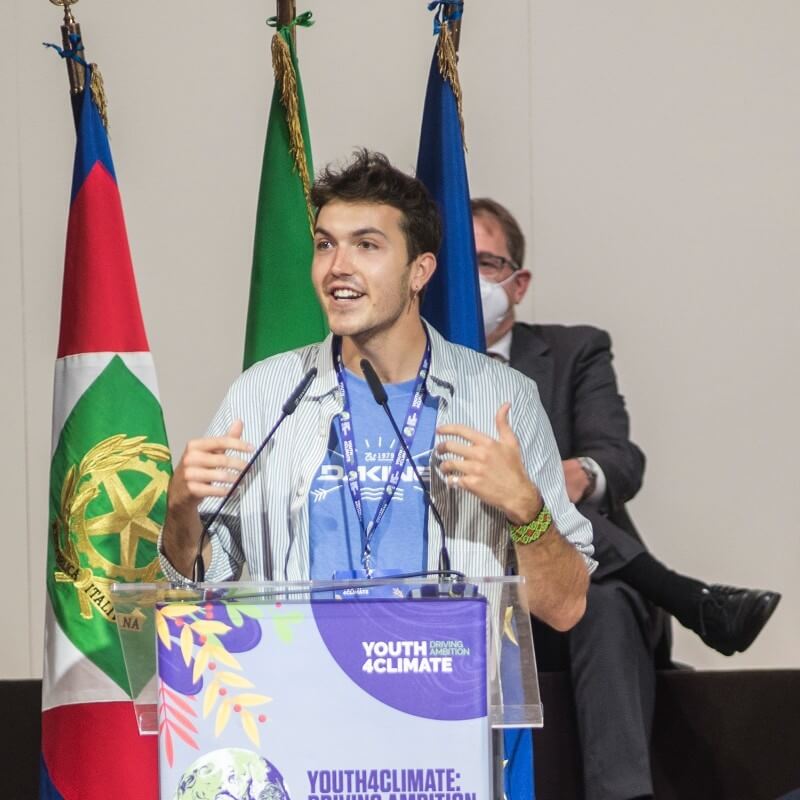
“It was young people who moved climate change to the front of the global agenda,” said UNFCCC Executive Secretary Simon Stiel on the eve of the recent COP27 climate summit in Egypt. Stiel’s words came as hundreds of young people gathered in Sharm el-Sheikh to raise their voices and call for more rapid climate action and a more just world.
The recent wave of youth-led climate justice action has emerged extremely quickly. Only 13 months after Greta Thunberg’s first solo strike at the Swedish Parliament in August 2018, more than 7 million young people were participating in climate protests in more than 140 countries around the world. While Covid-19 put the brakes on street-level protests, the movement has continued to evolve — asserting the need for urgent climate action, giving new traction to climate science, establishing a new and salient political constituency, and embodying the need for an intersectional and justice-focused approach.
In Europe, the wave of youth-led protests during 2018 and 2019 contributed to a Green Wave, which culminated in the best-ever results for Green candidates in the May 2019 European Parliament elections. Youth organizing helped persuade decision-makers to develop the European Green Deal. Meanwhile, in the United States, the work of the Sunrise Movement and other youth organizers helped push climate change to the fore as an issue in the 2020 U.S. presidential election cycle, which led Democratic candidates to adopt the most ambitious climate platforms to date and paved the way for the historic Inflation Reduction Act and other legislative action on climate.
The energy from this youth-led organizing has helped to revitalize the wider climate movement. Like their political counterparts, leaders in climate philanthropy are increasingly acknowledging the power of youth action, which has contributed directly to many of their priorities — including inside track advocacy, climate finance campaigning, strategic litigation, and opposition to new fossil fuel projects.
Youth-led climate justice initiatives remain severely underfunded
Given this momentum, how much and how well is philanthropy investing in youth-led climate justice movements? Over the last few months, The Hour Is Late has collaborated with a group of young climate leaders (initially brought together by U.N. Secretary-General António Guterres in his first Youth Advisory Group) in a bid to answer these questions, with funding support from the Children’s Investment Fund Foundation. Outputs from this collaboration — based on desk research and interviews — are available on the Youth Climate Justice Study website.
Our research reveals that foundation giving to youth-led climate justice initiatives is extremely limited — accounting for just 0.76% of climate mitigation funding from the world’s largest climate foundations across the three financial years 2019, 2020, and 2021.
This figure is based on The Hour Is Late’s analysis of grants data gathered by the ClimateWorks Foundation Global Intelligence team and is consistent with findings from a deep dive into European climate mitigation funding published in October 2021.
In the United States, grants to youth-led climate justice work represented only 1% of all funding for U.S.-based climate mitigation work. Together, the “top 10” climate grantees in the United States (many of them ‘Big Green’ environment groups based in Washington D.C.) received 20 times as much funding as was directed to youth-led climate organizing.
Nonetheless, the amount of available funding in the United States for youth-led work still dwarfed the available funding in other parts of the world. In fact, youth-led initiatives in the United States received nearly 16 times as much funding as the global average, relative to the size of youth populations in different countries. It would require an additional $158 million per year in foundation funding for all countries in the world to receive similar funding levels to the United States.
The challenges faced by youth-led climate justice organizers
In addition to increased funding, youth campaigners around the world see a need for different approaches to grantmaking. Much youth climate justice action takes place at a grassroots level and is led by small, new, or informal organizations. This dynamism is essential to how the movement scales its work, but it does not always correspond well with the conditions that foundations set for their grantees. The slide deck and call to action on the project website explore what youth-friendly grantmaking practices look like — for example, flexible grants that are light on administration, along with funder relationships built on respect and trust.
Over the course of the Youth Climate Justice Study, we interviewed young climate organizers based in Africa, the Americas, Asia, Europe, and Oceania and asked them about the challenges they face and what they need from funders. One frequent risk is burnout connected to the pressures of volunteering while balancing work, school, and family commitments — and financial scarcity exacerbates this challenge. Interviewees point out that the lack of remunerated roles presents a barrier to young people from historically excluded backgrounds, limiting recruitment and retention prospects at a time when youth movements need to increase diversity.
Security is another major concern given the high-profile arrests and persecution of youth activists in several countries, along with the criminalization of protest and other tactics associated with youth movements. One interviewee says, “In some countries and some communities, it is more dangerous to be an environmental defender. It is important that within financial support, there is [provision] for the protection of the people involved”.
Although our interviewees are very clear that youth leaders must hold the power to pursue their own agendas and ideas, they are hungry for support in the form of movement infrastructure, mentorship, and training. As one interviewee said, “After a few years, we won’t be part of the youth anymore. The most difficult thing has to do with building the ecosystem and forming new leaders to join and keep doing the work.” Another said, “Well-established networks can promote climate justice through all influencing levels, from the grassroots to the international.” Several interviewees highlighted the value of convenings and events, where youth from different countries have a chance to meet, learn, and mingle. There were multiple examples of youth-led organizations founded after such events, often with the help of modest start-up grants.
One overarching message that emerged from our interviews was how difficult it is for youth-led initiatives to access funds, with problems ranging from identifying potential funders to fulfilling reporting requirements. One interviewee said, “We didn’t know who to ask or where to even start looking. It’s overwhelming to work on all this and the actual campaign as well.” Another commented, “Often funders expect to see a lot of institutional stability or audited financial reports. How many grassroots organizations can provide all of this?” Yet another interviewee simply said, “Raising funds feels like incredibly hard work.”
A call to action for philanthropy
Investment is needed right now to address these risks and better support youth-led initiatives. Ultimately, there are huge opportunities for foundations to help accelerate ambition on climate mitigation by directing more funding to youth-led climate justice movements. Young climate campaigners have achieved a huge amount even with the very limited funding available, despite the fact that youth leaders often find themselves fundraising rather than mobilizing their peers. It is worth imagining what they could accomplish if their funding were doubled or tripled, particularly in countries in the Global South that have to date been starved of philanthropic grants.
There are positive signs that the philanthropy sector is starting to respond to this opportunity, with a growing number of re-granting organizations helping funders to get money closer to those doing the work while ensuring that young people are represented in governance and decision-making. This includes the Youth Climate Justice Fund, a new youth-led participative initiative in partnership with the Urban Movement Innovation Fund. Additional re-granting funds are listed in the slide deck on the Youth Climate Justice Study project website.
We encourage philanthropies that are committed to tackling climate change to explore the work of these funds and to commit themselves to increase the funding for youth-led initiatives around the world. As Katie Eder of the Future Coalition notes, “Youth may be 25% of the population, but we are 100% of the future.”



